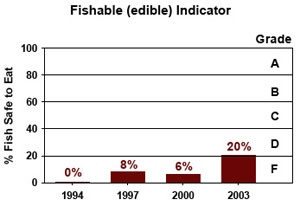When it comes to our health, the Bay-Delta's fish are flunking out of school.
 This past Sunday's San Francisco Chronicle Magazine featured an eye-opening story on Cambodian subsistence fishers in Stockton and the health concerns they face from a diet dependent on Delta fish. The piece illustrates how water quality in the Delta is an ecosystem issue and a public health issue and an environmental justice issue as well: The Delta's subsistence fishers--who often come from among the area's immigrant populations--face disproportionate exposure to contaminants in Delta fish.
This past Sunday's San Francisco Chronicle Magazine featured an eye-opening story on Cambodian subsistence fishers in Stockton and the health concerns they face from a diet dependent on Delta fish. The piece illustrates how water quality in the Delta is an ecosystem issue and a public health issue and an environmental justice issue as well: The Delta's subsistence fishers--who often come from among the area's immigrant populations--face disproportionate exposure to contaminants in Delta fish.
Like the Delta, the Bay supports numerous recreational and subsistence fishers. But they, too, need to be cautious about how often they indulge in a fresh-caught meal from the Bay. For The Bay Institute's San Francisco Bay Index--a "report card" on the health of the Bay released in 2005--our scientists crunched numbers from Bay monitoring projects. They found that 80% of the common sport fish caught in the Bay exceeded EPA screening levels for human consumption for at least one contaminant. That was actually an improvement from our previous report card, which looked at data from the year 2000 and found that 94% of fish sampled exceeded screening levels.
The contaminants studied include mercury, an element that occurs naturally in the Coast Range. Historic mining of mercury and gold released substantial amounts of mercury into the Bay's watershed, where it continues to wash downstream to the Bay and persist in Bay sediments. They also include "legacy" contaminants such as PCBs, DDT, and Chlordanes, poisonous chemicals whose manufacture is now banned or restricted but which, decades later, continue to hang around in the Bay environment. All of these contaminants are absorbed by plankton and biomagnify as they move up the food web, concentrating in the flesh of the larger sport fish favored by anglers. In humans, their effects can range from neurological disorders to developmental abnormalities to cancer.
How much Bay fish is too much? California's Office of Environmental Health Hazard Assessment recommends that women past childbearing age and men eat no more than two meals per month of San Francisco Bay sport fish. Women of childbearing age and children are advised to eat no more than one meal of Bay fish per month.
The good news is that decades of efforts to implement the Clean Water Act have reduced direct discharges of pollutants to the Bay. The bad news is that polluted runoff and sediments continue to be a problem, and reduced freshwater inflows and the loss of wetlands have crippled the Bay's abilities to absorb and filter contaminants. In addition, more than century of pollution has left its impact on the Bay--an unhappy legacy still finding its way onto our dinner plates.
